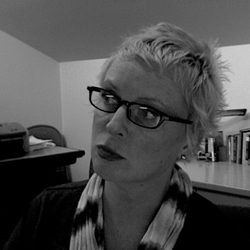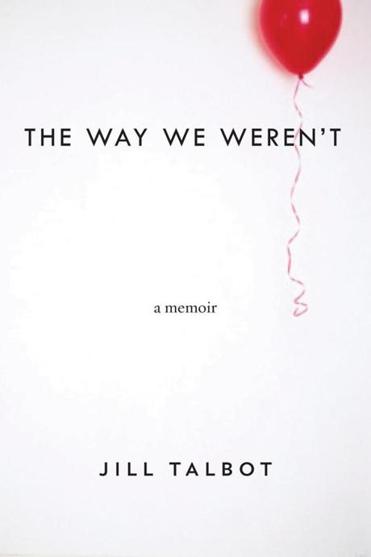
I knew Jill Talbot before I met her, having read her “debate” about facts and creative nonfiction with Brevity’s Dinty W. Moore on the magazine’s blog in the spring of 2012. I didn’t agree with everything she wrote about blurring lines between genres and the blending of the imagined with the remembered, but I admired her courage nevertheless. Dinty might very well be the nicest guy in our field, but he’s also scary-smart and a purist when it comes to genre distinctions. I wouldn’t want to argue with him, that’s for sure—and I admired her for stepping up and voicing her convictions. Plus, she worked at St. Lawrence University—my alma mater. I love SLU, and liked seeing a member of its English Department getting some attention.
At the time, Jill Talbot struck me as a writer on the rise, someone whose professional life was going well while mine was sputtering to a humiliating end. I had recently been told by both my dean and my provost that the president of the small Baptist school where I had been working for the previous four years had decided that my own memoirs and personal essays were too revealing, could offend our more conservative trustees, and might wind up being bad for fundraising. So my tenure application—which the provost had insisted just months before would be a “slam dunk”—was rejected at the highest level, and I had to figure out what came next.
Oddly enough, what came next was a job offer from my beloved alma mater—a visiting assistant professorship at St. Lawrence University. I wound up meeting Jill Talbot at a party towards the end of the summer, and we realized we lived next door to one another on East Main Street—she in 89, me at 91. We also realized that we shared affinities for both personal essays and white wine, and found ourselves often hanging out at my apartment, sipping cheap Chardonnay and talking about David Shields, Pam Houston, or Joan Didion. And on those nights when, perhaps, we each had a glass or two too many, we talked about the disappointments of the past—my anger at the immoral cowards who had fired me, her heartbreak over being abandoned by her daughter’s father, Kenny.
 I had either read or heard most of the stories recalled in her new book, The Way We Weren’t, before I sat down to read the memoir a few weeks ago. Many of these chapters were originally published as standalone essays in magazines like The Fiddleback, The Pinch, and The Normal School, and as Jill and I became friends, I began to read her work as it appeared in these magazines. While I admire the work of all of my writer friends, Jill’s work has its own particular power. She has an engaging voice, of course—a voice that says things like, “We go to Adam and Camille’s to measure our misgivings against their Neil Young CD collection and Crate & Barrel cutlery.” But she also has this ability to seemingly stop on a dime, shift her focus, and pull the rug out from under you in a way that causes you to realize—usually in any given essay’s final few sentences—that you are not reading the essay you thought you were reading. Though she is a Texan and not what most people would call “Southern,” I find her writing often reminds me of William Faulkner or Flannery O’Connor—you’re reading along, pretty sure you know where you’re going, and then suddenly—an iron-gray hair on a pillow! Or a hearse-like car approaching the scene of the accident! And all at once, the world doesn’t quite make sense like it did a moment before and you’re left whispering to yourself, “Oh shit, oh shit, oh shit.” More than once, I have had to get up from my desk and “walk off” a Jill Talbot essay, I was so emotionally shaken by what I had read. This is, I think, high praise.
I had either read or heard most of the stories recalled in her new book, The Way We Weren’t, before I sat down to read the memoir a few weeks ago. Many of these chapters were originally published as standalone essays in magazines like The Fiddleback, The Pinch, and The Normal School, and as Jill and I became friends, I began to read her work as it appeared in these magazines. While I admire the work of all of my writer friends, Jill’s work has its own particular power. She has an engaging voice, of course—a voice that says things like, “We go to Adam and Camille’s to measure our misgivings against their Neil Young CD collection and Crate & Barrel cutlery.” But she also has this ability to seemingly stop on a dime, shift her focus, and pull the rug out from under you in a way that causes you to realize—usually in any given essay’s final few sentences—that you are not reading the essay you thought you were reading. Though she is a Texan and not what most people would call “Southern,” I find her writing often reminds me of William Faulkner or Flannery O’Connor—you’re reading along, pretty sure you know where you’re going, and then suddenly—an iron-gray hair on a pillow! Or a hearse-like car approaching the scene of the accident! And all at once, the world doesn’t quite make sense like it did a moment before and you’re left whispering to yourself, “Oh shit, oh shit, oh shit.” More than once, I have had to get up from my desk and “walk off” a Jill Talbot essay, I was so emotionally shaken by what I had read. This is, I think, high praise.
Part of what makes Jill Talbot so successful as an essayist and memoirist—and this is a bit odd to say, given her public statements about the ways facts can be blended with fiction in this type of writing—is the unflinching, sometimes cruel honesty she employs when talking about herself. Her relationship with Kenny seems self-destructive on both of their parts, at times—she hates him for leaving even as she acknowledges that, in some ways, maybe she was the one who left the relationship first. She is someone who will complain about her poverty even while springing for an unnecessary hotel room so she can go swimming. At times, the wine that we both enjoy seems to have a pretty tight hold on her, leading her to make phone calls she shouldn’t make and take risks that a single mother perhaps ought not take. She knows herself well, and she is fearless when it comes to sharing that knowledge with her readers.
Jill Talbot has, in fact, been criticized for what she reveals about herself in her nonfiction writing. Peruse the Amazon reviews of one of her previous books and you will find perfect strangers issuing proclamations about her drinking, her sex life, and her fitness as a mother. And at least one nitwit reviewer of this most recent book has felt empowered to render judgment upon the artist based upon the art. It is, of course, sophomoric to render such judgment, and suggests a pretty serious misunderstanding of the difference between the persona on the page and the person who sits at the computer and composes the manuscript. Perhaps more importantly, it not only presumes that it’s possible to “know” a writer based solely upon the book she has written, but that the quality of the book can and should be determined based upon the reader’s perceptions of the author’s morality.
(Also, it seems to me that this substitution of moral judgment for serious aesthetic thought is only applied to the works of female nonfiction writers. Time and again, I’ve seen readers and reviewers call into question the “character” of writers like Talbot, Joan Didion, and Cheryl Strayed. Has anyone ever said, “Stop-Time ends with Frank Conroy driving drunk—therefore, the book is bad” or “Ernest Hemingway was a lousy husband—one star for A Moveable Feast?” I doubt it. So though I happen to know for a fact that Jill is a responsible person and dedicated mom, I’m not going to delineate exactly how and why I know these things in this review—to do so would be to show profound disrespect for both the work under discussion and its author).
Serious nonfiction readers know that the appeal of the genre is that it gives us insight into the mind of another human being. None of us has telepathy, and even the most empathetic of us can’t really experience the world as another person experiences it. So we read essays and memoirs. We pay attention to the authors who are able to make their own lives and thoughts vividly present to us. This is what Jill Talbot does, and she does it so well it can be unsettling at times.
Last month, I mentioned on Facebook that The Way We Weren’t is so good, “I almost wish Jill wasn’t such a close friend, because I’d like to write and publish a review of this book in order to encourage more people to read it.” I worry that you might finish reading this and conclude that I’m recommending this book to you, that I’m identifying this as the last book I loved, because it was written by my friend. This is not the case—in fact, it’s kind of the opposite. While I have no doubt Jill and I would have been cordial towards each other even if I didn’t like her work, I don’t think she would be my friend—my very close friend—if I hadn’t read her essays in the early days of our friendship. When I first encountered Jill—both in person and on the page—I was solipsistic in my anger, grieving for a career I had lost, a career to which I had felt entitled. I was overwhelmed with my own pain, to the point that I wasn’t always able to see the suffering of others. But good nonfiction writing—the type of nonfiction writing produced by a writer like Jill Talbot—forces us beyond such self-centeredness, compels us to consider the life and struggles of another person, makes us more compassionate and thoughtful people. Jill Talbot’s work reminded me of these truths at a very important point in my life.
Jill Talbot’s proximity made her my drinking buddy for the academic year 2012-2013; it was her essays—many of which are now chapters in this new book—that made her my very good friend.




